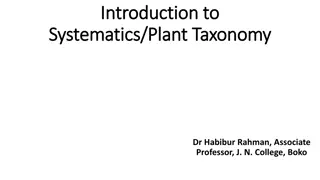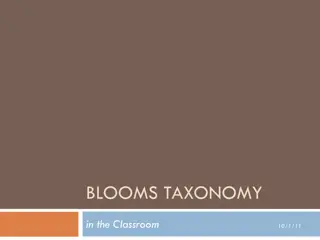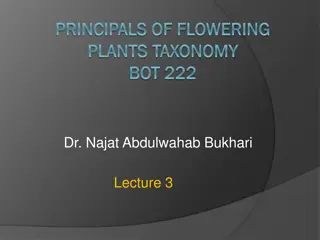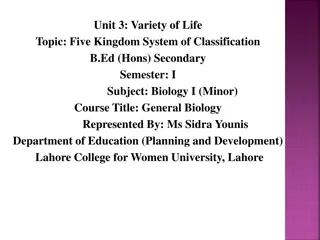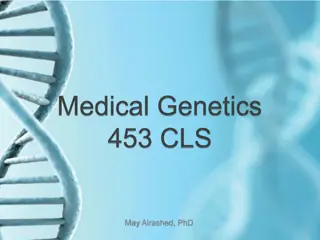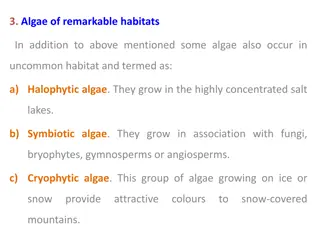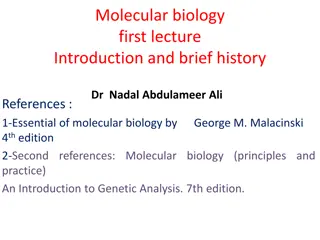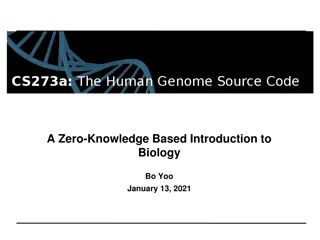Understanding Taxonomy and Classification in Biology
Scientists use classification to group organisms logically, making it easier to study life's diversity. Taxonomy assigns universally accepted names to organisms using binomial nomenclature. Carolus Linnaeus developed this system, organizing organisms into species, genus, family, order, class, phylum, and kingdom based on physical similarities and evolutionary descent. Phylogeny and evolutionary classification further group organisms based on evolutionary history. Modern classification includes six kingdoms: Eubacteria, Archaebacteria, Protista, Fungi, Plantae, and Animalia.
Download Presentation

Please find below an Image/Link to download the presentation.
The content on the website is provided AS IS for your information and personal use only. It may not be sold, licensed, or shared on other websites without obtaining consent from the author. Download presentation by click this link. If you encounter any issues during the download, it is possible that the publisher has removed the file from their server.
E N D
Presentation Transcript
Why Classify? Scientists classify organisms into groups in a logical manner to make it easier to study the diversity of life. Taxonomy: assigning each a universally accepted name. Assigning Scientific Names Each species has been assigned a name for classification purposes. Binomial Nomenclature: system used in classification. The fist name is always capitalized and represents the Genus of the animal. Genus: The second name is specific to that type of animal. Taxonomy: The discipline of classifying organisms and Binomial Nomenclature: The two part scientific naming Genus: A group of closely related animals, for example; bears
Carolus Linnaeus: Developed binomial nomenclature. Linnaeus s hierarchical system of classification includes seven levels. The seven layers from smallest to larges are as follows. Taxon organisms are classified. Species Genus Family Order Class Phylum Kingdom. Linnaeus grouped organisms based on physical similarities and he only had two kingdoms; Animalia & Plantae. Taxon: : A group or level of organization into which
Species can breed and produce fertile offspring. Genus: Family: characteristics. Order: Class: Phylum: Kingdom: of closely related phyla. Species: A group of similar organisms that Genus: A group of closely related species. Family: A group of genera that share many Order: A group of similar families. Class: A group of similar orders. Phylum: A group of closely related classes. Kingdom: Large taxonomic group, consisting
Dichotomous Key: plant or animal in which each stage presents descriptions of two distinguishing characters, with a direction to another stage in the key, until the species is identified. Dichotomous Key: A key used to identify a
Phylogeny: relationships among animals. Evolutionary Classification: grouping organisms together based on their evolutionary history. Biologist group organisms based on evolutionary descent or phylogeny, not just physical characteristics. Derived characters: in recent organism lineage but not in older organisms. Cladogram relationships. Phylogeny: The study of evolutionary Evolutionary Classification: The strategy of Derived characters: Characteristics that show up Cladogram: : A diagram that shows evolutionary
There are six (6) kingdoms in modern classification; Eubacteria, Archaebacteria, Protista, Fungi, Plantae, and Animalia. The Three-Domain System: Modern Biologist have created a new taxonomic category called domain. Domain: than a kingdom. There are three domains: Eukarya, Bacteria, and Archaea. Domain: is a more inclusive category and is larger
Eukarya cellular. Kingdoms: Protista, Fungi, Plantae, Animalia Bacteria: Kingdom: Eubacteria Archaea extreme environments. Kingdom: Archaebacteria Eukarya: : Eukaryotic, complex, maybe multi- Bacteria: Unicellular, prokaryotic Archaea: : Unicellular, prokaryotic, live in
Classification of Living Things Classification of Living Things Domain Bacteria Archaebacteria Eukarya Kingdom Eubacteria Archaebacteria Protista Fungi Plantae Animalia Cell Type Prokaryotic Prokaryotic Eukaryotic Eukaryotic Eukaryotic Eukaryotic Cell Number Unicellular Unicellular Mostly Unicellular Some Multicellular Mostly Multcellular Some Unicellular Multicellular Multicellular Mode of Nutrition Autotroph & Heterotroph Autotroph & Heterotroph Autotroph & Heterotroph Autotroph Heterotroph Heterotroph Examples E. Coli Streptococcus Methanogens Halophiles Amoeba Paramecium Mold Mushrooms Yeast Mosses Ferns Sponges Mammals Fish


